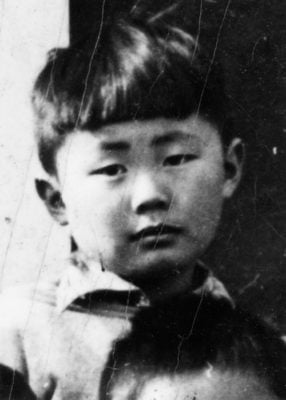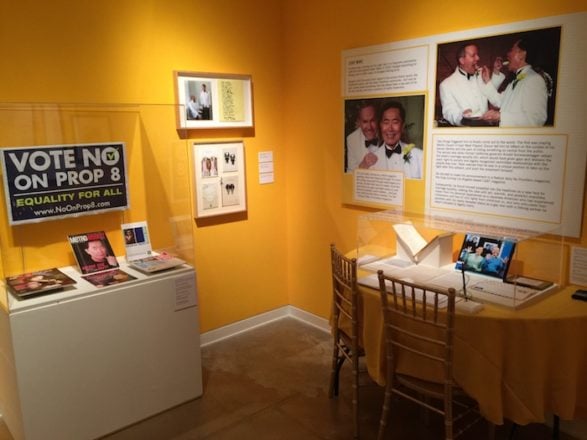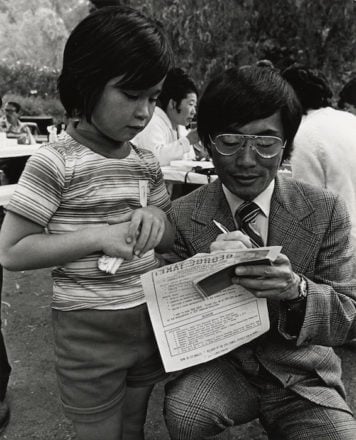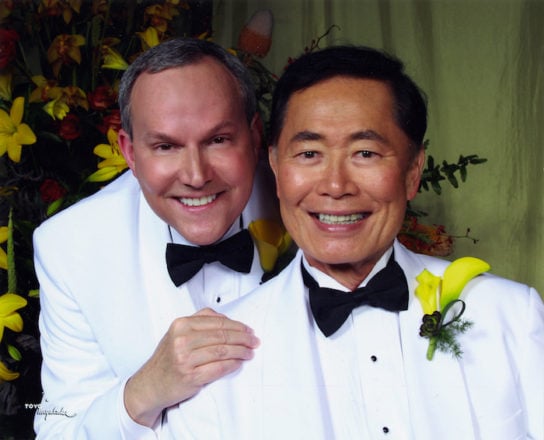LITTLE TOKYO — The sweeping exhibit “New Frontiers: The Many Worlds of George Takei” takes visitors on the journey that is Takei’s life: From a 5-year-old boy imprisoned with his family on two Japanese concentration camps during World War II and an intergalactic helmsman navigating the USS Enterprise on “Star Trek” to an LGBTQ activist and 80-year-old social media darling.
The exhibit is on display at the Japanese American National Museum through August 20.
RELATED: George Takei’s life takes center stage in exhibit
Here are eight things you need to know about Takei’s life and the exhibit.

George Takei as a 5-year-old boy in the concentration camp at Rohwer, Arkansas, during World War II. Photo: George & Brad Takei Collection, Japanese American National Museum.
Forced into concentration camps
At the age of 5, Takei was one of more than 120,000 Americans of Japanese descent who were ordered into concentration camps during World War II. Takei, who was born in Los Angeles, spent three years in the camps.
In 1942, the Takei family was forced to live in the converted horse stables of Santa Anita Park before being sent to the Rohwer War Relocation Center in Rohwer, Arkansas. The family was later transferred back to California and sent to the Tule Lake War Relocation Center.
RELATED: A rare look at gay life in Japanese internment camps
Painful experience inspires art
George’s father, Norman Takekuma Takei, made an abstract sculpture from a cypress tree while the family was incarcerated at the internment camp in Rohwer, Arkansas. That piece is the first item visitors see when they enter the “New Frontiers” exhibit.
“The story begins with the wood his dad brought from Arkansas,” said curator Jeff Yang. “Something that was tragic and turned into something that transcends the space. It’s climbing out of pain and moving forward.”
Takei boldly went where he had never gone before
When California Gov. Arnold Schwarzenegger vetoed a bill that would have legalized same-sex marriage, George Takei went boldly where he had never gone before — He publicly told the world he is gay.
Takei and his boyfriend, Brad Altman, had been a couple for 18 years (They married in 2008), and Takei’s sexuality had been an open secret in some circles since the 1970s. Also, Takei didn’t conceal his active membership in LGBTQ organizations.
But the renowned actor perhaps best known as Lt. Hikaru Sulu on the sci-fi classic TV series “Star Trek” never went public about his sexual orientation — until 2005 when Schwarzenegger terminated an attempt at marriage equality.
“We thought long and hard about coming out,” Takei told Q Voice News. “I rememeber as a tenager, my favorite heart throb was Tab Hunter.
“When he was exposed as gay, he didn’t make any more movies,” Takei said. “It was ingrained in my mind — You can’t be out and be an actor.”

Part of the “New Frontiers” exhibit at the Japanese-American National Museum focuses on George Takei’s role as an LGBTQ activist. Photo: Q Voice News staff photo
Beam me up, Howard
After publicly coming out, Takei appeared on “The Howard Stern Show” in 2006. Takei decided to join Stern in the studio after using Vulcan logic.
“If we are going to make change, it has to come from more than the LGBT community,” Takei said. “I maintained that the middle of America is made of of decent, fair-minded people who are too busy making a living to think about issues or get involved. How do we reach them?
“Brad was reluctant,” Takei said.
Stern chartered a course
The shock jock asked a series of explicit, sex-related questions about Takei’s personal life, which Takei answered with a jovial sense of humor. “I didn’t understand how high a price I would have to pay. He wanted to know how we did it, and I said it was like wrestling,” Takei said with a laugh.
“That was on the first show. When I got back to the apartment, Brad didn’t say a thing. He wouldn’t talk to me,” Takei said. “I took him to a romantic dinner. I had to woo him back with dinner.”
Coming out of the closet
Takei’s segment on “The Howard Stern Show” was so popular that he made frequent appearances on the radio show and received an unexpected career boost.
“I started getting offers from television for guest shots. I made a whole career out of that. I worked like mad. My career just took off,” he said.
“I also got other offers I never would have gotten, Pizza Hut and Taco Bell commercials. It was totally unexpected. We thought my career would wind down. It was refreshing and revitalizing, and it replenished our bank account,” Takei said with a chuckle.

George Takei signs a campaign flyer during his 1973 run for Los Angeles City Council. Photo: George & Brad Takei Collection, Japanese American
National Museum.
“New Frontiers” items
The items are from The George & Brad Takei Collection, the museum’s largest collection about any one individual. In September 2016, Takei and Altman donated a treasure trove of poignant and never-before-seen materials. Here are some items on display:
- Materials from Takei’s 1973 Los Angeles City Council campaign
- One-of-a-kind artworks made by his legions of fans
- The walking stick Takei carried on his ascent of Japan’s Mount Fuji
- The Olympic torch he carried in the lead-up to the 1984 Summer Olympic Games in Los Angeles
- George and Brad’s wedding photos
- The key to the city of Roanoke, Virginia. Takei traveled to Roanoke in 2016 to meet with Mayor David Bowers, after Bowers mentioned the use of Japanese American concentration camps to justify suspending the relocation of Syrian refugees to the city.
Pledging ‘Allegiance’
Takei not only starred in the musical “Allegiance,” but also helped secure funding. Inspired by Takei’s story of living in the internment camps during World War II, the play will debut next year in Los Angeles.
“It’s my legacy project,” Takei said. “It’s the story of the internment project and how it broke up the Japanese-American community and some families.
“We get to tell the stories about people who went to fight for this country. Young Japanese-Americans rushed to recruitment centers as an act of patriotism, but were answered with a slap on the face,” Takei said. “They were denied military service and characterized as enemy aliens. We weren’t with the enemy, and we weren’t aliens. We were born right here. It was crazy, and then to put us in prison camps was even crazier.”

Brad and George Takei celebrate their 2008 wedding in this photo taken by Toyo Miyatake Studios. Photo:
George & Brad Takei Collection, Japanese American National Museum.
